CCTV surveys for drainage is a massively important part of maintaining property and allows you to be proactive in identifying potential and existing issues that could be cost more in the long run by not being aware of root causes or underlying issues within and around the property.
But not all surveys are created equal.
It doesn’t matter whether you’re managing or responsible for a residential block, commercial unit, or public facility; this guide will walk you through what drain surveys are, when and why you need one, how the reporting should work, and finally how to choose a contractor that meets professional standards whilst remaining cost effective.
What Is a CCTV Drain Survey? And What Should you get with it from a Property Management Perspective?
A CCTV drain survey is a non-invasive inspection of underground drainage systems using high-resolution cameras. It allows your contractor to detect hidden issues like cracks, root ingress, pipe degradation, or blockages—without any excavation.
For property and FM professionals, these surveys play a vital role in:
- Diagnosing tenant complaints (smells, backups, damp, repeated blockages)
- Planning preventative maintenance – a lot cheaper and manageable in the long run.
- Supporting insurance claims – literal video and documented proof.
- Meeting compliance standards in risk-sensitive environments – covering yourself to show you’re maintaining the very system that can prevent pollution and harm to the environment and people.
The key difference at this level is reporting integrity. You need more than a camera and a video—you need structured, MSCC-compliant outputs that can be stored, shared, and acted on.
How Does a Drain Camera Work?
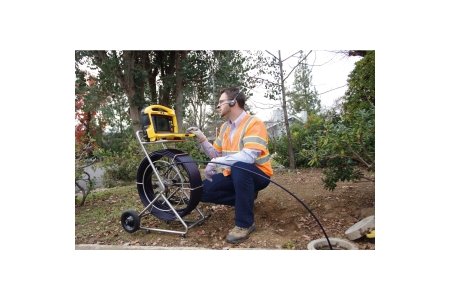
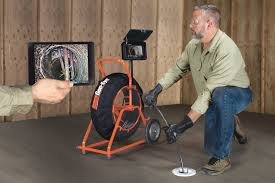
The cameras themselves can be basic or high end, with HD output and high intensity light, from a simple endoscopic-type camera plumbers may carry around, to highly specialised robotic camera capable of sending themselves (attached via a fibre optic cable) hundreds of metres up and down pipes.
As long nothing is in the way, that is.
The camera:
The camera end has a protective “skid” or covering around it to avoid damaging the sensitive parts. As you can imagine, it wouldn’t take much knocking around dodgy pipes with displaced joints, debris and grotty waste to damage the camera, where a lot of the cost is if in need of repair.
The skids are sized specifically for most sizes of sewer pipes found underground, for example the two most common are 100mm (4″) and 150mm (6″), so the allocated skids will hold the camera exactly in the middle of the pipe for both the best view and to keep it up and away from any sludge, paper, or other bits that can obscure the view.
[INSERT ILLUSTRATION OF CAMERA IN PIPE]
As you can see above, the camera lens is central to the whole camera end, with a ring of lights around it, and the protective skid on the outside.
The camera is attached to a fibre optic cable, flexible enough to be pushed into a drain pipe via whichever access is available, such as an inspection chamber, but strong enough to withstand being pushed and pulled and protected on the outside from knocks, abrasions, water, etc.
The next component is the frame which holds the camera and cable, often called a reeler or coiler, which holds the entire fibre optic cable within the frame, and then finally the camera box, or unit, (usually) sits on top of the frame.
The camera box is linked to the frame via a short cable which both powers the lights and receives the camera signal.
The unit is where the business end happens in terms of data input and recording, with at the very least a small display to show the camera operator what the camera can see, set the distance and input the job details.
Drainage cameras can be simple or complicated, but this is the gist of the components. Crawler cameras have many more components but even these follow the same concept.
A Drain Survey is only as Good as the Information put in when Recording the Information
A vital part of a drain survey is not only making notes of the manhole, inspection chambers, etc. and where they run to/from, but also depths (inverts), pipe material, sizes, etc and generally as much information as possible, including photos of the chambers, access points and areas being surveyed.
This can massively help with working out quotes and potential issues with a plan of action; not to mention enabling the customer and third parties to fully understand the condition of the drainage system and highlight both prominent issues and things to be aware of.
This can also help plan a PPM to ensure your drainage system is repaired and maintained in a cost effective, planned-out manner.
🔵 H2: When Should You Use CCTV Drain Surveys?
Here are common situations where a drain survey should be part of your maintenance or investigative workflow:
Repeated blockages or slow running drains
Some people can put up with blockages if it’s no more than an annual occurrence, even if it’s due to a known issue such as roots.
But if you have a regular drainage issue that isn’t obvious (such as you can see above ground pipe doesn’t have enough gradient (or fall), a CCTV survey could save you substantial cost in the long run – especially if it highlights an easy fix.
If you’ve had a flood, persistent smells, backups, or water ingress, a CCTV inspection can identify the source and give you documented evidence for insurance or dispute resolution.
It’s worth checking if you use a regular drainage contractor how they charge for their services.
In my experience charging for a two hour minimum for a CCTV survey would include light jetting (HPWJ) to get a clear image, and clearing blockages within this time frame was included (as long as the total was within the two hours); this not only shows a willingness to be cost effective and look after the customer (by not piling on up sells) but also provides the engineer with an insight as to where and why the blockage is occurring as they can see it in real time.
So you get a “free” drain clearance and the contractor gets valuable information as to why the blockages are occurring.
Compliance
This is more for facilities and property manager-types who manage commercial buildings, premises and land. It can also apply to anybody managing or responsible for properties on a remote basis.
What better way to prove the condition of the property’s assets than literal video, photos and maps?
Whether a starting survey to map and highlight the drainage system of your property, or an ongoing CCTV survey to check the status of repairs and ongoing pre-planned tasks such as descaling (removing scale) or degreasing (removing fats, oils, and food waste), there is no better way to keep on top of your drainage system, and as above regarding being cost effective, a CCTV survey as part of a PPM or repairs should not affect your overall costs, if anything it should be included in the quoted package.
After an incident such flooding or even fire
This is where it’s worth surveying your drainage, even if you think the horse is bolted, such as you’ve had a flood so a survey won’t prevent it. However, you can work quickly work out what caused the flood and how to prevent it, or at least minimise the risk.
Your insurers will appreciate this!
pre-planned maintenance (ppm’s)
As part of carrying out annual drain maintenance, or biannual, or monthly, or whatever regularity, a survey will provide proof to you and those you answer to that the PPM is worthwhile and shows you’re keeping your drainage assets in top shape.
handovers such as refurbs or end-of-tenancy inspections
Be it a small flat or acres of land, or a simple house with very little drainage or a manufacturing or warehouse property, a handover CCTV drainage survey should be viewed as priceless to all parties.
If you’re handing over a property or project, whether you worked on the drains or not, you can prove you left them in the same state you found them.
If you’re on the receiving end, you’ll know the drainage is still functional, or whatever terms were agreed have been upheld. Win-win!
Especially in commercial or mixed-use buildings, drain condition affects value, liability, and future access. Get a record of baseline condition before or after occupation.
grease management and environmental piece of mind
This was an everyday discussion when I actively worked in drainage. From the humble, domestic kitchen gully, to the commercial kitchen pumping out thousands of plates per week, FOG is everywhere and it isn’t a matter of “I don’t put oil down the sink,” but a matter of reducing the little but regular bits of residues, food, waste oil, plate scraps that escaped the bin, etc.
If you become aware that fat and grease is a factor in causing problems, it’s best to get in front of it and not only remove it from your drains, but create a plan of action that could prevent it. This could be as simple as a sink strainer or complex as installing a grease trap with enzyme solutions. A survey will highlight where the source is coming from, and where potential control measures may be needed.
In food environments (restaurants, schools, hospitals), CCTV is a key tool for monitoring FOG buildup in waste systems—especially in kitchens, pot wash zones, and floor gullies.
📣 Optional CTA:
Need a survey as part of a handover or repair plan?
Check out our asset handover checklist (coming soon) or speak to a local contractor with commercial CCTV experience.
🔵 H2: What’s Included in a Professional Report?
A proper CCTV drain survey report should follow recognised industry standards and give you confidence in what you’re seeing and what’s been recorded.
Here’s what it should contain:
Here’s what it should contain:
| 🧾 Structural & Service Grading | The surveyor will use MSCC5/WRC codes to classify pipe defects and service issues, from scale buildup and root ingress to cracking and displacement. These are typically graded 1–5 or “A–D” based on severity. |
| 📸 Video & Image Evidence | Full video of each run inspected Key screenshots showing identified issues Sonde/locator data if used (to pinpoint location and depth) |
| 📍 Drainage Layout & Flow Direction | Most reports will include a schematic or simple layout map showing manhole numbers, entry points, flow direction, and pipe sizes/materials. |
| 🛠️ Action Plan & Recommendations | Rather than just listing issues, a good report should guide you toward next steps—be it cleaning, patch repairs, relining, or full replacement. |
📎 Bonus Tip: Ask if the contractor can provide data in a GIS-compatible format for future asset mapping or CAD integration – this will help with future CAD drawings and keeping things up to date.
🔵 H2: How to Choose the Right Contractor
This is often where things go wrong—cheap surveyors with basic kit and no reporting standards.
Here’s what to look for:
✅ Accreditations
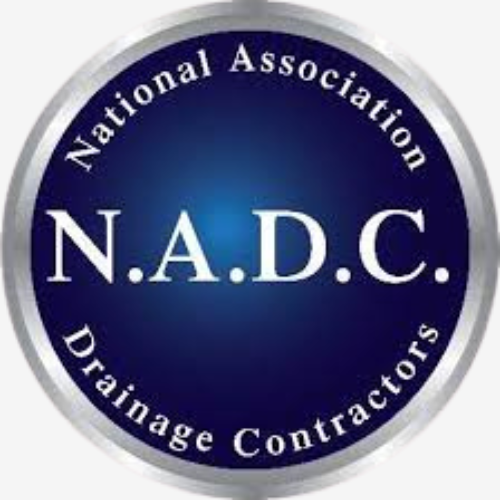
NADC-certified (National Association of Drainage Contractors)
The NADC is the UK’s leading trade body for the drainage industry. Certification ensures contractors meet rigorous standards in safety, workmanship, and professionalism.

OS19X-qualified
The OS19X qualification is a key competency for CCTV drain surveyors in the UK. It covers the safe and accurate classification of sewer defects to national standards, often required by water companies.
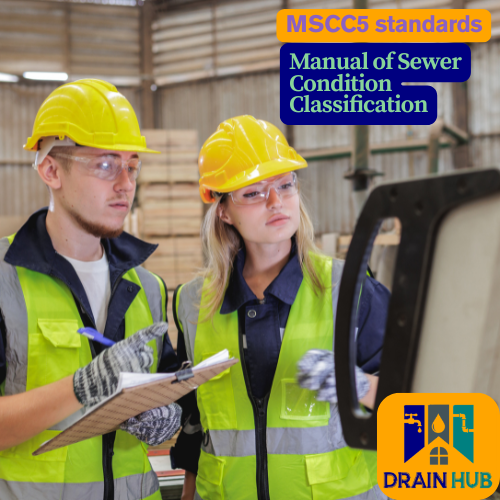
MSCC5 standards (or equivalent)
MSCC5 (Manual of Sewer Condition Classification) sets the industry standard for defect coding in drain surveys. It ensures that inspections are conducted and reported in a consistent, accurate way for asset managers and drainage engineers.
✅ Track Record with Commercial / FM Clients
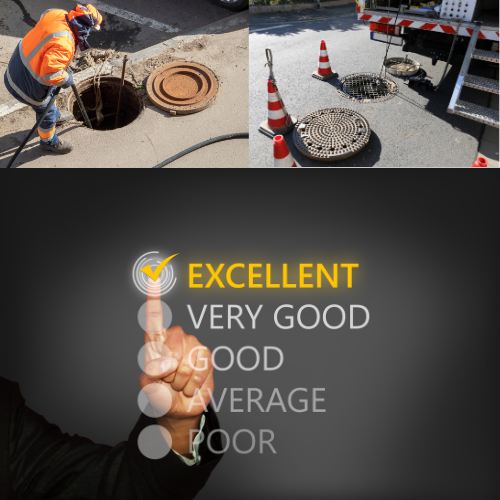
It isn’t just prices that you need to work out, but also their quality of reports, how organised they are with surveys and repairs, etc.
It’s so much easier when a contractor knows the site and expectations from the client, such as Safe Systems of Work, Permits, quirks of the building, etc. and this enables them to build a picture of what you need usually makes the works from then on much more cost effective.
An easy way to gauge the quality of a drainage contractor you haven’t worked with is to request a sample of their reports, post survey:
EAsy checks to make
- Is the report clear and well-structured?
- Does it include location data, a defect grading, and decent, easy to grasp photos?
- Can you see how it would be compatible with your asset documentation? For example instead of just “F1 to F2,” some clients need more specific manhole (or node) numbers according to existing plans.
- Have they done work on similar to sites to your’s?
- Construction sites
- Blocks of flats
- Residential
- Commercial
- Retail
- Manufactoring
- Rural
- Would stakeholders, decision makers and laypeople understand the report? Such as:
- What the information means
- Where the surveyed pipes are
- What repairs are needed and why
- A simple but comprehensive plan of repairs, including any repairs they cannot carry out? (Some contractors can’t install lining, or excavations)
✅ Post-Survey Support
Will they walk you through the footage? Provide quotes for next steps? Support further investigation if required?
A good survey doesn’t end at delivery—it’s part of an ongoing maintenance cycle.
Need help assessing a report or comparing contractors?
We don’t sell surveys—but we can help you make sense of them.
Do You Really need a Drainage CCTV Survey?
CCTV surveys aren’t just for emergencies—they’re a key part of proactive asset care, compliance, and long-term drainage planning.
Done right, they give you visibility, confidence, and documented evidence you can rely on.
Done poorly, however, and they can waste time and give you nothing actionable.
Invest in proper reporting, work with experienced contractors, and build surveys into your wider FM strategy.
feedback
If you have any questions or want to clarify anything regarding drainage surveys, feel free to get in touch or leave a comment below.

Leave a Reply